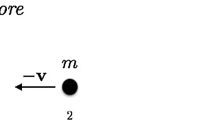Abstract
It will be argued that Minkowski's implementation of distances is inconsistent. An alternative implementation will be proposed. In the new model the proper time of an object is taken as its fourth coordinate. Distances will be measured according to a four dimensional Euclidean metric. In the present approach mass is a constant of motion. A mass can therefore be ascribed to photons and neutrinos. Mechanics and dynamics will be reformulated in close correspondence with classical physics. Of particular interest is the equation of motion for the proper time momentum. In the classical limit it reduces to the classical law of conservation of (kinetic+potential) energy. In the relativistic limit it is similar to the conservation of energy of the theory of relativity. The conservation of proper time momentum allows for an alternative explanation for Compton scattering and pair annihilation. On the basis of the proper time formulation of electrodynamics also an alternative explanation will be offered for the spectra of hydrogenic atoms. The proper time formulation of gravitational dynamics leads to the correct predictions of gravitational time dilation, the deflection of light and the precession of the perihelia of planets. For this no curvature will be needed. That is, spacetime is flat everywhere, even in the presence of sources of gravitation. Some cosmological consequences will be discussed. The present approach gives a new notion to energy, antiparticles and the structure of spacetime. The contents of the present paper will have important implications for the foundations of physics in general.
Similar content being viewed by others
References
H. Minkowski, Phys. Z. 20, 104 (1908); reprinted in The Principle of Relativity (Dover, NewYork, 1923).
T. E. Phipps, Jr., Heretical Verities (Non-Fiction Library, Urbana, 1986), p. 37.
J. R. Fanchi, Found. Phys. 23, 487 (1993).
L. P. Horwitz and C. Piron, Helv. Phys. Acta 46, 316 (1973).
L. P. Horwitz and A. Soffer, Helv. Phys. Acta 53, 112 (1980).
L. P. Horwitz and Y. Lavie, Phys. Rev. D 26, 819 (1982).
R. Arshansky and L. P. Horwitz, Phys. Rev. D 29, 2860 (1984).
R. Arshansky and L. P. Horwitz, J.Math.Phys. 30, 213 (1988).
F. H. Gaioli and E. T. Garcia-Alvarez, Gen. Relativity Gravitation 26, 1267 (1994).
J. M. C. Montanus, Phys. Essays 4, 350 (1991).
J. M. C. Montanus, Phys. Essays 6, 540 (1993).
J. M. C. Montanus, Hadronic J. 22, 625 (1999).
A. Shadowitz, Special Relativity (Saunders, 1968), p. 22.
B. Nodland and J. P. Ralston, Phys. Rev. Lett. 78, 3043 (1997).
P. Marmet, Phys. Essays 9, 96 (1996).
T. E. Phipps Jr., Phys. Essays 4, 368 (1991).
D. E. Spencer and U. Y. Shama, Phys. Essays 9, 476 (1996).
P. Moon, D. E. Spencer, and E. E. Moon, Phys. Essays 4, 249 (1991).
R. B. Driscoll, Phys. Essays 7, 355 (1994).
R. Hatch, Galilean Electrodyn. 6, 51 (1995).
F. Selleri, Open Questions in Relativistic Physics (Apeiron, Montreal, 1998), p. 69.
T. L. Gill, Found. Phys. 28, 1561 (1998).
H. A. Lorentz, Kon. Akad. Wetensch. Amsterdam 1, 74 (1892); English version: Collected Papers 4 (Nijhoff, Den Haag, 1934- 1939), p. 219.
J. M. C. Montanus, Phys. Essays 10, 666 (1997).
C. Jeffries, Phys. Essays 8, 168 (1995).
Y. Huang, Phys. Essays 8, 532 (1991).
J. M. C. Montanus, Phys. Essays 11, 395 (1998).
A. O. Barut, Electrodynamics and Classical Theory of Fields and Particles (Dover, New York, 1980).
J. M. C. Montanus, Phys. Essays 11, 280 (1998).
T. L. Gill, W. W. Zachary, and J. Lindesay, Found. Phys. Lett. 10, 547 (1997).
J. M. C. Montanus, Phys. Essays 10, 116 (1997).
T. L. Gill, W. W. Zachary, and J. Lindesay, Int. J. Theor. Phys. 37, 2573 (1998).
R. Eisberg and R. Resnick, Quantum Physics of Atoms, Molecules, Solids, Nuclei and Particles (Wiley, NewYork, 1974), p. 112.
J. M. C. Montanus, Phys. Essays 11, 563 (1998).
H. Arp, Seeing Red (Apeiron, Montreal, 1998).
H. Arp, Astrophys. J. 496, 661 (1998).
J. Narlikar and H. Arp, Astrophys. J. 405, 51 (1993).
R. Hatch, Galilean Electrodyn. 6, 73 (1995).
C. K. Whithey, Galilean Electrodyn. 11, 2 (2000).
C. M. Will, Was Einstein Right? (Basic Books, NewYork, 1986).
Author information
Authors and Affiliations
Rights and permissions
About this article
Cite this article
Montanus, J.M.C. Proper-Time Formulation of Relativistic Dynamics. Foundations of Physics 31, 1357–1400 (2001). https://doi.org/10.1023/A:1012274211780
Issue Date:
DOI: https://doi.org/10.1023/A:1012274211780



